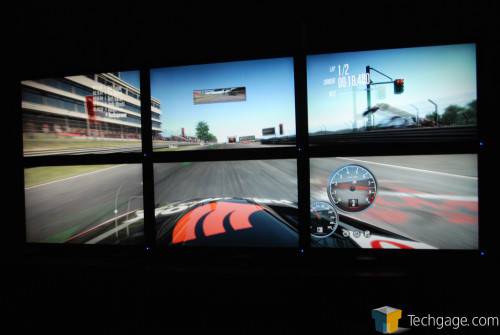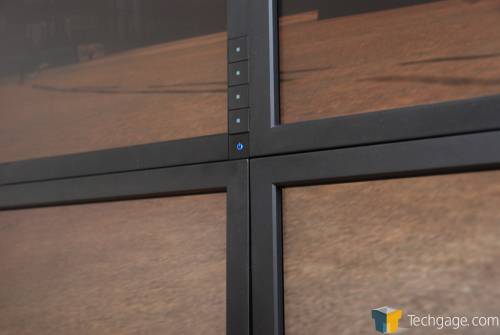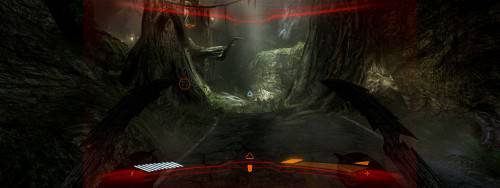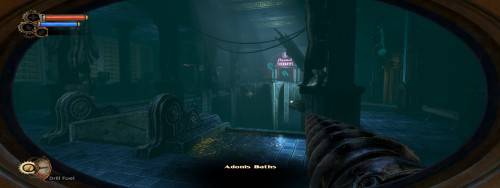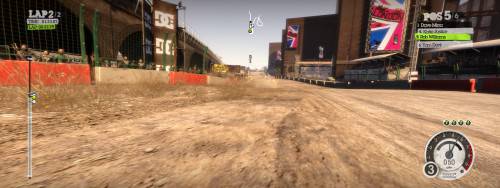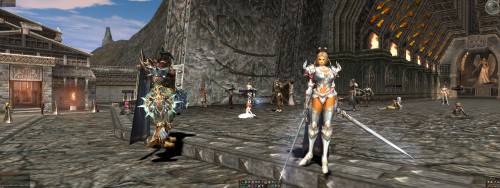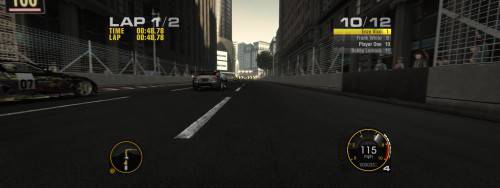- Qualcomm Launches Snapdragon 4 Gen 2 Mobile Platform
- AMD Launches Ryzen PRO 7000 Series Mobile & Desktop Platform
- Intel Launches Sleek Single-Slot Arc Pro A60 Workstation Graphics Card
- NVIDIA Announces Latest Ada Lovelace Additions: GeForce RTX 4060 Ti & RTX 4060
- Maxon Redshift With AMD Radeon GPU Rendering Support Now Available
ATI Radeon HD 5870 Eyefinity 6 Edition Preview
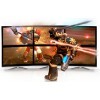
Think having three monitors is a little bland? How about six, then? Options were scarce before, but with AMD’s ATI Radeon HD 5870 Eyefinity 6 edition, it has never been easier to get hooked up with such a configuration. We’re still in the process of “working” hard for our final article, so for now, we give you this preview.
Thanks to a couple of releases that have occurred in the past week, it feels like it could have been called the “High-End Gaming Week”! First, NVIDIA released its GF100-based GeForce GTX 470 and 480 cards, which we took a look at here, and now, AMD has announced its “Eyefinity 6” edition of the Radeon HD 5870. Why 6? Because it supports 6 displays, of course. If that’s not “high-end”, I don’t know what is!
Beginning with the HD 5000 series launch last fall, AMD has been pushing its multi-display technology quite hard, and as it stands, the company has the most robust solution available. Until it launched, NVIDIA was rather quiet about the entire prospect, and it wasn’t until this past January when it unveiled support for multiple monitors (up to three, currently). Despite NVIDIA’s Fermi launch being rather uneventful, AMD is clearly not taking any mercy and has happily announced Eyefinity 6.
As you could expect, Eyefinity 6 isn’t for the weak of heart. For one, it’s a technology that’s obviously designed for six displays, and even with modest 20″ models, that’s going to take up a lot of room. Second, you need the Eyefinity 6 edition graphics card, which includes six mini-DisplayPort connectors on the back. It also boosts the available GDDR5 to 2GB and carries a higher price tag of $479.

Because the card includes mini-DisplayPort connectors, you’ll need to use adapters in order to hook up all six monitors without issue. Five adapters will be included in the box, not six (for some reason), so you’ll need to purchase an additional connector or connectors (if you want to use the same adapter for each, since the boxed card will only include 2x DisplayPort, 2x DVI and 1x HDMI). It can be assumed that vendors such as Sapphire will sell editions of the card that include all of the same adapter, and six in total.
We’ve had an Eyefinity 6 setup in our lab for the past month, and have been putting it to good use. Due to various delays that have plagued me lately, I haven’t been able to get up a complete review posted up to this point, but that will be coming within the next week (Monday is likely). The setup includes 6x Dell P2210H 22″ monitors which each support a resolution of 1920×1080. Combined in a 3×2 configuration, that gives us a total resolution of 5760×2160. That equates to 12.44 megapixels, or 3x the number of pixels in the 2560×1600 resolution. Here’s a small preview of how the setup looks:
Eyefinity 6 isn’t only “big”, it’s a “big” hassle to get set up, unless you really have some insane skills. No, I’m not talking about the software, or anything that has to do with AMD. I’m talking about the mounts! I ended up breaking a piece due to it being so complicated, and believe it or not, I even had to use tape at the end of it all in order to even them out (and even now, the placements are only about 95% perfect).
But that aside, once everything was hooked up and the PC was turned on, taking care of the initial configuration wasn’t too much of a hassle. You don’t have to worry about plugging the cables into a respective port on the back of the card, because the Catalyst software will allow you to rearrange the displays to whatever makes sense, and then keep it that way.
As a whole, the setup software-wise is a bit finicky, but as long as you have patience, it’s easy to overlook its faults. That’s not to say that the faults lay with AMD, because they might not. One example is when you turn off a monitor (even accidentally). The driver will automatically detect the change and reconfigure itself as necessary. Even if you turn on the monitor again immediately, it can take upwards of a minute or more to settle itself down. Again, I’m not sure if this is the driver’s fault, or just the fact that it’s a challenge to continue sending configuration information to the card and vice versa to the PC.
The other issue if of course the display bezels. Even AMD itself admits that Eyefinity is more targeted towards 3 displays, but the ability to use 6 is there for those who want them. To put things into perspective, if you are using a 3×1 configuration, you only have 2 sets of bezels dividing up the gameplay. With 3×2, you have 7. That’s obviously going to get some getting used to, and as you’d expect, it does make playing some games more of a hassle than its worth.
For our full review, I’ll give a run-down of my experience with a bunch of popular games, some of which AMD has “validated” and some of which it hasn’t. Validation essentially tells you that the game is as good as can be given the strange configuration, with the official list being found here. If a game isn’t listed, don’t fret… depending on the title, you might have no issue with it. I’ve tested games not listed on that page at all and the result is actually quite good.
So how about a small sample of what games look like at such a sky-high resolution? There are six examples below, and all are available at their original resolution of 5760×2160. Be warned, though… even when saved as a lossy JPEG, these images weigh in at between 1MB – 2.8MB!
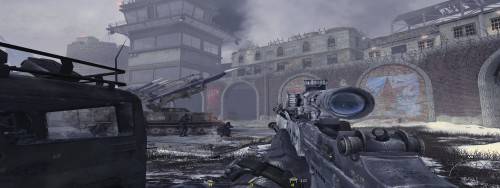
Call of Duty: Modern Warfare 2
One thing you might notice is that these screenshots are not only widescreen, but very widescreen. While 1920×1080 is a 16:9 ratio, and 2560×1600 a 16:10, 5760×2160 has an incredible 16:6 ratio. This might seem a little “too” widescreen, but the setup suits it, and it’s not something you notice while playing. What it does mean is that if you run games that don’t support Eyefinity in any real way, then some of the graphics may have a stretched look (kind of like watching stretched SD television on an HDTV).
Again, this is something that doesn’t seem to be too noticeable during gameplay, but one game that kind of stands out is Modern Warfare 2. It’s hard to tell unless there’s a comparison, though, so that’s what I plan to do… side-by-side screenshots of 16:10 and 16:6 ratios in games and see how each fare.
Some games are built to scale though, so the result can be rather impressive. Take Lineage II, for example. This is a title that came out almost exactly six years ago, yet it looks perfect at 5760×2160 (well, minus unscaled UI, but that’s to be expected). The characters aren’t stretched, but still natural. The difference is just how much you can see at once, and overall, the experience was quite unique.
This is as much as I’ll talk about Eyefinity here, but I’ll be getting to work soon on putting the virtual pen to the virtual paper and preparing a far more in-depth look to post soon. In the meantime, if you have any questions you’d like answered, feel free to ask them in our related forum thread. You never know… you might just ask about something I didn’t consider!
Stay tuned!
Discuss this article in our forums!
Have a comment you wish to make on this article? Recommendations? Criticism? Feel free to head over to our related thread and put your words to our virtual paper! There is no requirement to register in order to respond to these threads, but it sure doesn’t hurt!
Support our efforts! With ad revenue at an all-time low for written websites, we're relying more than ever on reader support to help us continue putting so much effort into this type of content. You can support us by becoming a Patron, or by using our Amazon shopping affiliate links listed through our articles. Thanks for your support!




